| Manufacturer: | Scratch |
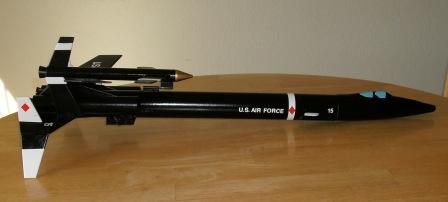
Brief:
The SR-72 is a parachute recovery mothership with a parasite glider.
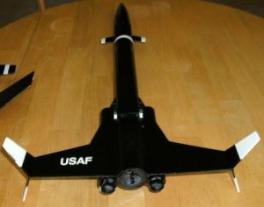
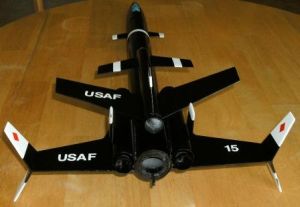
Construction:
Box o' Parts Contest Entry: Constructing the SR-72. The idea of the Box O' Parts contest is to construct a rocket from a random collection of parts that fit into a Priority Mail tube. The only other items you can add are the bonus items selected by EMRR. My bonus items were:
- Two ping-pong balls
- A pencil
- Dental Floss
- A pill bottle
- A prize from a cereal box.
The box I received from Howard Smart held a great variety of parts. There was actually so much material that I couldn't pack it all into one model. What I ended up using from the box were:
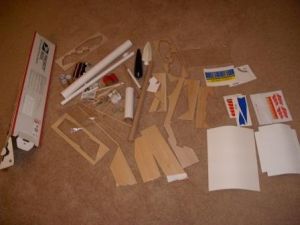
- BT-60 Body tube 18" long
- BT-50 body tube cut into one 2-¾" and two 6" pieces
- BT-20 body tube 7-½" long
- BT-20 nose cone
- BT-60 (Der Red Max style) nose cone
- SR-71 nose cone
- Balsa sheets
- 36" shock cord kit
- 3/16" dowel (Sanded down to 1/8")
- Shroud sheet
- Card stock
- BT-50 to BT-55 centering rings
- BT-50 thrust ring
- Engine hook
- 1/8" Launch lugs
I tinkered around with the parts for some time before settling on a design. I was inspired by a model of the SR-71 Blackbird that carried a reconnaissance drone in a piggy-back configuration. I decided I wanted to build a boost glider model based on the concept of a piloted mothership with a parasite drone that would be launched at high altitude to penetrate enemy airspace. I decided to call the model the SR-72.
I knew I wanted to build my rocket around the 18" BT-60 body tube, and I also liked the look of the SR-71 nosecone. Unfortunately, the SR-71 cone did not fit the BT-60 tube. In order to use it, I decided to cut the cockpit portion off of the nose cone and blended it into the BT-60 nose cone by wrapping sandpaper around the bigger cone and sanding the cockpit to fit . When the shapes were in contact all the way around, I glued them together with liquid plastic cement.
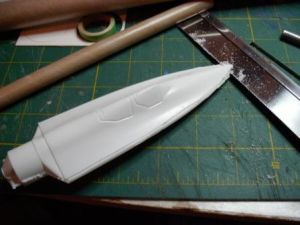
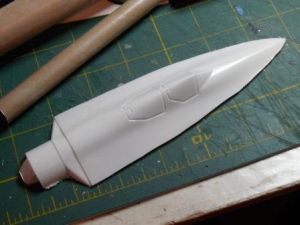
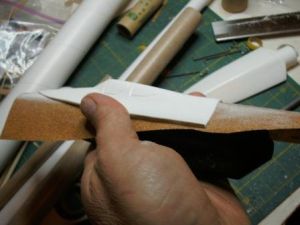

I knew a model of this size would need a large motor to get it into the air so I wanted to use the BT-50 tube for a motor tube. Unfortunately, I did not have BT-50 to BT-60 centering rings, so I made them by wrapping strips of the card stock around the BT-50 to BT-55 centering rings. I constructed a standard "D" size motor mount from a 2-3/4" piece of BT-50, the thrust block and engine hook. I then glued this assembly flush with one end of the BT-60.

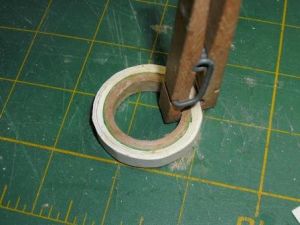

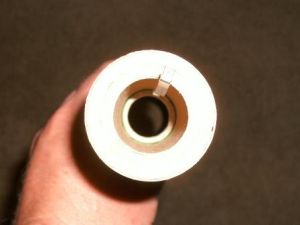
Next, I made the booster engines by cutting two pieces of BT-50, 6" long each. I then traced the tube onto one of the ping pong balls (the first bonus item) and cut out two end caps. I then cut them out and glued them to the ends of the boosters with epoxy.
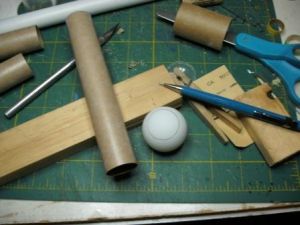

 Next, I glued these boosters to the main body using a technique I learned from Quest Rocketry's Force 5 kit. Laying the main tube on a flat surface and with the engine hook up, I placed the two boosters on the sides of the main tube, and flat on the table. Next, I applied a bead of glue down the booster tubes and rotated them until the glue was in contact with the main tube.
Next, I glued these boosters to the main body using a technique I learned from Quest Rocketry's Force 5 kit. Laying the main tube on a flat surface and with the engine hook up, I placed the two boosters on the sides of the main tube, and flat on the table. Next, I applied a bead of glue down the booster tubes and rotated them until the glue was in contact with the main tube.
While that assembly dried, I began cutting out fins. (You can use the template supplied to cut out all the balsa pieces.) Assemble the main wings by gluing the wing front to the wing. After this had dried, I sanded and sealed all the fins. I prefer to seal the balsa with a 50/50 mixture of wood glue and water and press the parts under a stack of books if they start to warp. The photo (below/right) shows all the balsa parts cut out, sanded, and drying.

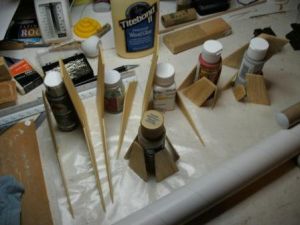
Next, I glued the wings to the main body. I marked where the wings crossed the boosters. Then I applied glue to the wing root and along the booster up to the mark. The photo (below/center) shows the way the wings and boosters go together with the three body tubes flat on the table. I supported the wingtips in this configuration until they dried.


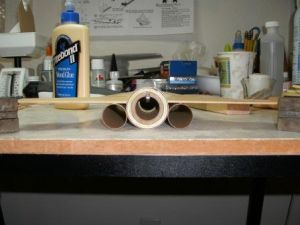
While that assembly dried, I began work on the glider. First I took the 7-½" BT-20 tube and marked it with 4 lines 90 degrees a part. Extend these lines the entire length of the tube. With one line face-up I glued the wing halves together ½" from the tube end sanding the root edges for a good fit, and letting the wingtips rest on the work surface to form a natural dihedral.
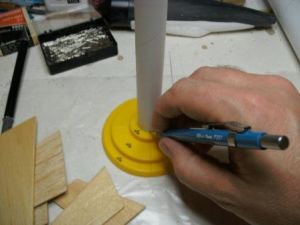

While the glider wings dried, I glued the wingtips onto the wing of the mothership. The exact angle of the tips isn't critical, but I tried to make them all even. I cut a cradle out of the Priority Mail tube and used it to hold the model as it dried.
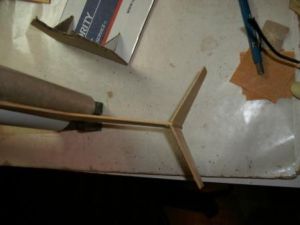
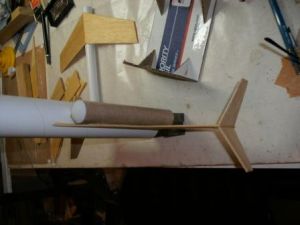

I then glued the rest of the parts to the glider. The canards go on the two side lines ¼" from the front of the tube and the tail goes on the top line, flush with the back of the tube. Once everything is dry, fillet all the joints.
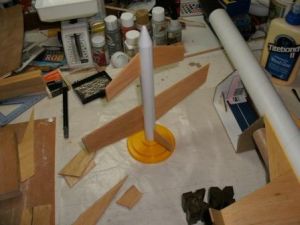
Next, I glued the strakes to the top of the model in the joint between the boosters and the main body.

The glider rests on these strakes and is hooked to the booster by a 1" long piece of launch lug and a hook constructed from a dowel and a balsa stand-off. The launch lug is glued along the top center of the model 6-¼" from the back of the tube, and the hook is glued to the glider along the wing center line and flush with the front. The exact size of the stand-off took a little trial and error to get the glider rest parallel to the mothership's wing. Start with a stand-off about 3/16" for the launch lug and a 3/8" for the dowel. Tape them in place and check that the glider rests correctly. If not, sand them until the glider rests in line with the main wing so that the glider will not distort the flight path of the rocket. When dry, place the glider on the mothership, and place the rudders/glider support fins against the boosters. Mark the rudders where the glider wings cross them. At this mark, cut a notch into the fins and glue them in place so that the notch holds the glider wing stable during boost.
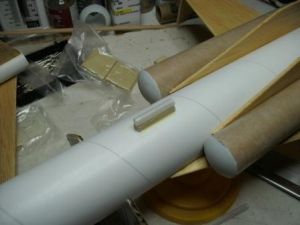

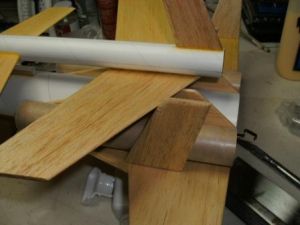
Two of the surprise items were a pill bottle and a cereal box prize. I used a square pill bottle and a Batman disc launcher to make an air scoop.
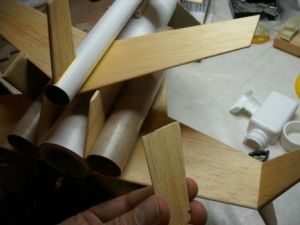
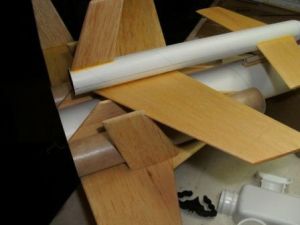
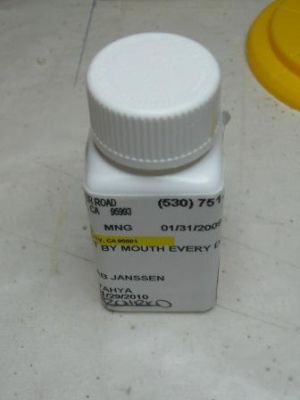
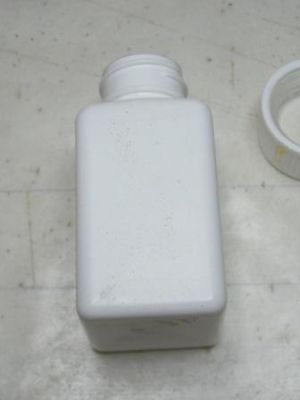
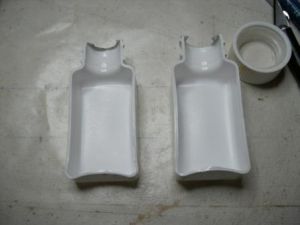
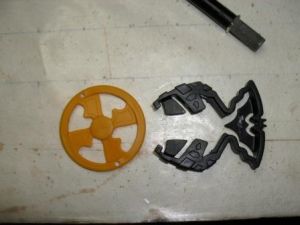

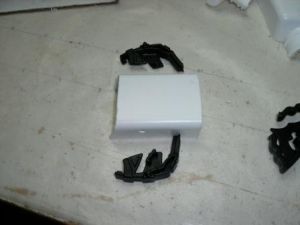
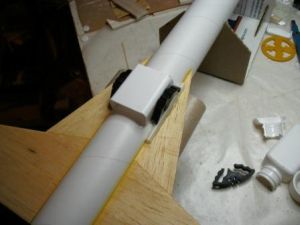
Taking the last of the two ping pong balls, cut one disc for the BT-20 and two discs for the BT-50 boosters.
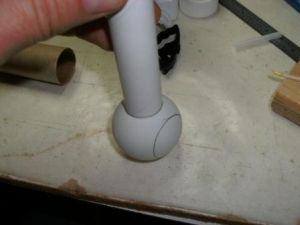
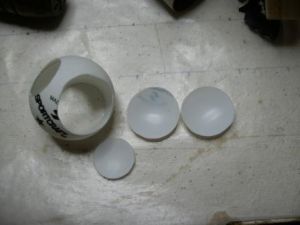
Use the shroud pattern to trace out three shrouds from card stock. Form these shrouds into cones and glue them and the ping-pong ball discs to the rear of the boosters and the glider.
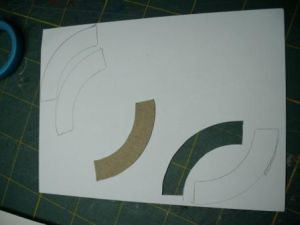
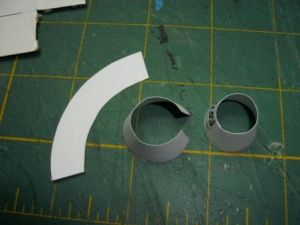

 Next, glue the two canards to the sides of the main body tube 1" from the front of the tube.
Next, glue the two canards to the sides of the main body tube 1" from the front of the tube.
The two gun pods were made from a pencil (the fourth of the surprise parts). First I split a 6" length of pencil in two. Then I wrapped a piece of sandpaper around a piece of BT-60 and sanded the inside of the pencil so that it would rest flush with the body tube. Next, I cut the pencil into two 3" long pieces and tapered the ends. These two pieces were glued to the underside of the model approximately 60 degrees apart.
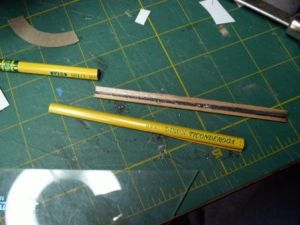
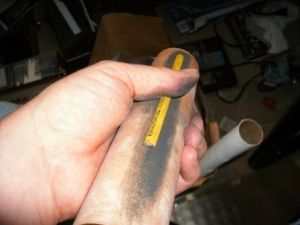
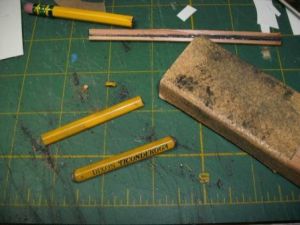

Finishing:
At this point, the model was ready for paint. I first painted Tamiya gray primer then over-coated it with flat white. Next, I painted the windows of the cockpit gloss sky-blue and the glider nosecone gold. In order to get the U.S. Air Force lettering, I used vinyl lettering as masking. I laid out all the letters on wax paper using pencil lines on paper as a guide. Next, I rubbed masking tape over the letters and peeled them off the wax paper. Using the tape, I applied the letters onto the model, and then peeled off the tape, leaving only the lettering behind. The rest of the stripes and the wingtips were masked off with Tamiya masking tape along with the cockpit windows.
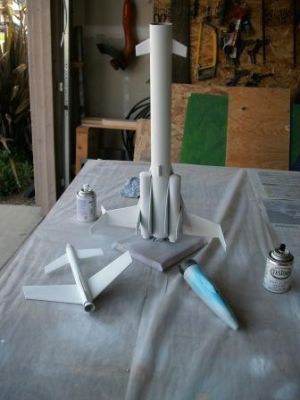



After painting the model gloss black, I peeled off the lettering to reveal the white undercoat. I used some of the "Black Diamond" decals that came in my box of parts to add a splash of color to the painted model.


I next glued a 36" x 1/4" Estes shock cord inside the body tube using an Estes cardstock mount.

The last bonus item was dental floss. I decided to use it to extend the shock cord and connect the nose cone to the rubber band. One strand of floss seemed too fragile, so I braided three strands together by tying one to the eye of the cone and looping another strand through. These I braided together for strength, and tied to the shock cord. I then attached the 18" parachute to the nose cone.
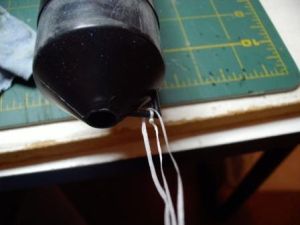

I glide tested the drone and added clay nose weight until it had a flat glide.
At this point, the assembly was complete and the rocket was ready for a test flight.
 Flight and Recovery:
Flight and Recovery:
On 5/22/09, my Box 'o Parts model made its maiden flight on a C11-3 (Flight #1). This test flight was of the booster only. The winds were about 5-10mph. The model took off nicely and flew straight up. It is very stable in flight. The ejection happened just past apogee and the rocket was pointed down. It managed to flip and hook the chute on the tailfins. The whole assembly came down in a flat spin and landed hard on the top. The two top tail fins snapped and folded over on impact, but it was otherwise undamaged.
I glued the fins back on that evening and returned to the field on 5/23/09. The second flight was on a D12-5, again with just the booster (Flight #2). This flight was a complete success. The rocket climbed out with authority and flew very straight. The parachute deployed at apogee and did not tangle. The rocket descended gently to a soft landing (Safe Landing). For the third flight I again used a D12-5 and attached the glider. The takeoff and climb-out were straight and true (Flight #3). The glider had no negative effect on the rocket's performance. The ejection occurred at apogee and the glider separated cleanly. The glide was uneven. The glider was stalling, but it looked to me that it just needs some fine tuning. The winds were shifting and gusting from 5-10 mph at this point so the rocket drifted into a nearby wheat field. It took a while to find in the tall plants (glider landing) but with the help of my friends we recovered the rocket and the glider.

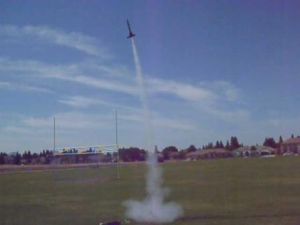
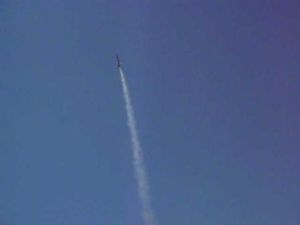


Summary:
I am very pleased with how the SR-72 turned out. I really like the flight performance, and it is a real head turner on the flight line. If I can find more room for glider tests and fine tuning I am confident it could be an impressive glider launcher as well.
The only thing I would change on this model would be to use a 3/16" launch lug and replace the rubber/dental floss shock cord with a Kevlar®/elastic one. You could also reverse the angle of the glider's wings to make it easier to balance.
Sponsored Ads
 |
 |











